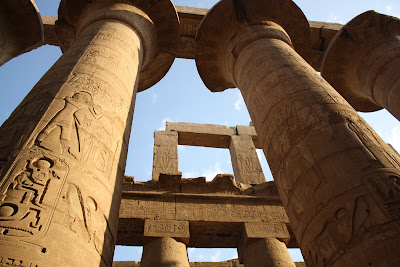The Valley of the Kings is home to 65 Egyptian tombs that
belonged to Pharaohs. The royal tombs were
built into the side of the limestone hills of the mountains and carved out of
sheer rock. The tombs were built deep
into the hills so they would discourage tomb robbers from stealing the possessions
buried with the pharaohs. Unfortunately
all of the tombs were robbed except for two or three tombs. One of the tombs left untouched was King Tutankhamun’s
tomb which is why today we are able to see so many magnificent ancient artifacts from his
reign.

Although the tombs were robbed and the treasure was stolen
the tombs were still amazing discoveries.
The tombs were covered with ancient art.
The walls were carved with symbols that gave the account of the journey
taken through the underworld. The
paintings on the wall were meant to help guide the pharaohs in the
afterlife.
As part of our tour we were able to see 3 tombs. I don’t remember which tombs we saw but I remember
the artwork on the walls and how impressive the paintings were in the tombs. The thing I remember the most about this part
of the tour was that we had a little trouble with the guards.
 I file this incident under the category “boys will be boys”. When we arrived for our tour in the Valley of
the Kings they told us no pictures. You
were absolutely not allowed to take pictures.
Often when visiting historical sites they won’t let you take pictures or
use flash photography because they say the flash can damage the artifact. The
tombs were very dark inside and had never been exposed to bright light so I
believe that was why they had the no picture rule. Well one of the boys in the group tried to slyly
take a few pictures without security noticing.
The bad news was that they had security guards inside dressed in normal
clothes that were watching the whole time.
So our friend was busted.
I file this incident under the category “boys will be boys”. When we arrived for our tour in the Valley of
the Kings they told us no pictures. You
were absolutely not allowed to take pictures.
Often when visiting historical sites they won’t let you take pictures or
use flash photography because they say the flash can damage the artifact. The
tombs were very dark inside and had never been exposed to bright light so I
believe that was why they had the no picture rule. Well one of the boys in the group tried to slyly
take a few pictures without security noticing.
The bad news was that they had security guards inside dressed in normal
clothes that were watching the whole time.
So our friend was busted.  I don’t remember exactly how the situation ended. I remember security guards threatened to keep the camera
but I think our friend was able to delete the pictures he took and then pay a fine to
get his camera back right there on the spot.
I remember thinking at the time that this situation reminded me of Mexico where you can
negotiate a bit with authorities. All in
all everything turned out well but unfortunately not one of us took a picture in the Valley ofthe Kings.
I don’t remember exactly how the situation ended. I remember security guards threatened to keep the camera
but I think our friend was able to delete the pictures he took and then pay a fine to
get his camera back right there on the spot.
I remember thinking at the time that this situation reminded me of Mexico where you can
negotiate a bit with authorities. All in
all everything turned out well but unfortunately not one of us took a picture in the Valley ofthe Kings.


























.jpg)





















